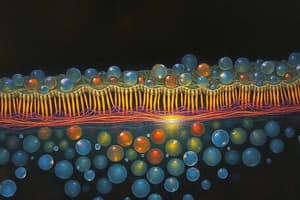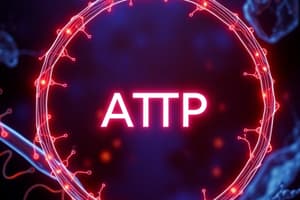Podcast
Questions and Answers
Which of the following best describes the substrates used in anaerobic respiration in humans?
Which of the following best describes the substrates used in anaerobic respiration in humans?
What is the primary waste product of anaerobic respiration in human cells?
What is the primary waste product of anaerobic respiration in human cells?
How much ATP is produced from one glucose molecule during aerobic respiration?
How much ATP is produced from one glucose molecule during aerobic respiration?
In which part of the cell does anaerobic respiration occur in humans?
In which part of the cell does anaerobic respiration occur in humans?
Signup and view all the answers
What is measured in a respirometer to determine the rate of cell respiration?
What is measured in a respirometer to determine the rate of cell respiration?
Signup and view all the answers
Why is it important that ATP is unable to diffuse through cell membranes?
Why is it important that ATP is unable to diffuse through cell membranes?
Signup and view all the answers
What is the main function of cell respiration?
What is the main function of cell respiration?
Signup and view all the answers
Which of the following is NOT a characteristic of ATP?
Which of the following is NOT a characteristic of ATP?
Signup and view all the answers
Which of the following processes does NOT require ATP?
Which of the following processes does NOT require ATP?
Signup and view all the answers
What is the main difference between ventilation and cell respiration?
What is the main difference between ventilation and cell respiration?
Signup and view all the answers
Which of the following is an example of anabolism?
Which of the following is an example of anabolism?
Signup and view all the answers
What is the significance of the chemical reaction ADP + phosphate + energy → ATP + H2O?
What is the significance of the chemical reaction ADP + phosphate + energy → ATP + H2O?
Signup and view all the answers
What is the significance of the fact that cell respiration happens inside every living cell?
What is the significance of the fact that cell respiration happens inside every living cell?
Signup and view all the answers
Flashcards
Aerobic Respiration
Aerobic Respiration
Cell respiration that requires oxygen and produces a large yield of ATP.
Anaerobic Respiration
Anaerobic Respiration
Cell respiration that occurs without oxygen and generates a small amount of ATP.
ATP Yield Comparison
ATP Yield Comparison
Aerobic respiration yields 30-32 ATP, while anaerobic yields only 2 ATP.
Respirometer
Respirometer
Signup and view all the flashcards
Waste Products
Waste Products
Signup and view all the flashcards
ATP
ATP
Signup and view all the flashcards
Properties of ATP
Properties of ATP
Signup and view all the flashcards
Conversion of ATP to ADP
Conversion of ATP to ADP
Signup and view all the flashcards
Regeneration of ATP
Regeneration of ATP
Signup and view all the flashcards
Cellular processes requiring ATP
Cellular processes requiring ATP
Signup and view all the flashcards
Respiration
Respiration
Signup and view all the flashcards
Hydrolysis reaction
Hydrolysis reaction
Signup and view all the flashcards
Condensation reaction
Condensation reaction
Signup and view all the flashcards
Study Notes
Cell Respiration
- ATP is the basic energy currency in cells, similar to money in countries
- ATP (adenosine triphosphate) is a nucleotide with adenine, ribose, and three phosphate groups
- ATP is chemically stable at neutral pH, soluble in water, and controls movement within cells. It releases energy (by removing a phosphate group).
- ATP can be easily regenerated by adding a phosphate group to ADP (adenosine diphosphate).
- ATP is used in many cellular processes, such as active transport and synthesis of macromolecules
- ATP conversions: ATP → ADP + phosphate + energy; ADP + phosphate + energy → ATP + H₂O
Cellular Processes Requiring ATP
- Four examples are active transport, synthesis of macromolecules (anabolism), movement of cell components (mitosis and meiosis), and movement of the whole cell (cell motility).
Converting Between ATP and ADP
- ATP and ADP are interchangeable
- Converting ATP to ADP releases energy
- Adding a phosphate group to ADP to make ATP requires energy that may come from various sources like sunlight, food oxidation and other phosphate group transfers.
- Conversion from ADP to ATP is a phosphorylation reaction; a condensation reaction as water is created.
- Converting ATP to ADP is a hydrolysis reaction; a water molecule is broken down
Respiration as a System for Producing ATP
- Respiration is a metabolic process where carbon compounds are oxidized to create ATP.
- Glucose and fatty acids are primary substrates
- Respiration occurs in all living cells
- Respiration is different from ventilation and gas exchange
- Ventilation is the movement of air in and out of lungs, and gas exchange is the swapping of gases at a surface where an organism interacts with its environment.
Comparing Aerobic and Anaerobic Cell Respiration in Humans
- Aerobic Respiration: Uses oxygen, utilizes sugars/lipids as substrates, produces a large yield of ATP (30-32 per glucose molecule), releases CO₂ and water as byproducts, and occurs in the cytoplasm and mitochondria
- Anaerobic Respiration: Does not use oxygen, utilizes glucose and other sugars as substrates, produces a small yield of ATP (2 per glucose molecule), produces lactate (lactic acid) as a byproduct, and occurs only in the cytoplasm.
- Example simple word equations for aerobic and anaerobic resp are given in the document.
Investigating the Rate of Cell Respiration
- Respirometers measure the rate of cell respiration
- The respirometer absorbs oxygen and releases CO₂ .
- Absorbtion of O₂ and release of CO₂ can be used to calculate the rate of cellular respiration.
- Potassium hydroxide is used to absorb CO₂ produced
- Temperature plays a role in air pressure changes, and should be controlled for accurate results. Respiration rate is usually measured as O2 consumption or CO2 release per unit time.
Studying That Suits You
Use AI to generate personalized quizzes and flashcards to suit your learning preferences.
Related Documents
Description
Explore the essential roles of ATP in cell respiration and various cellular processes. This quiz covers ATP's structure, its conversion to ADP, and its involvement in active transport and macromolecule synthesis. Test your understanding of how ATP functions as the energy currency of cells.



